The Article
Dino Phono Amplifier by Trichord
3rd January 2016
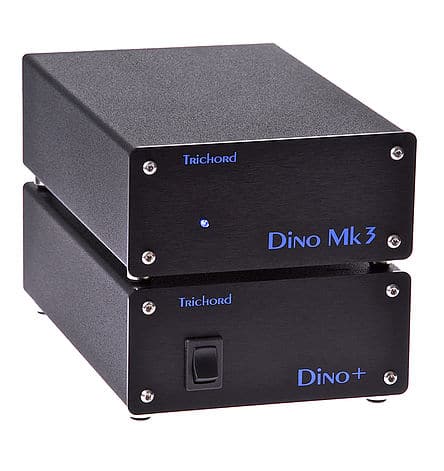
Trichord Research has a structured upgrade path to steadily improve the sound quality of its famed Dino Mk.3 phono stage. Paul Rigby reviews the entire chain of upgradable components to see what it offers including: the Dino Mk.3 itself, the Dino+ upgraded power supply, High Performance Lead and Never Connected upgraded power supply
Graham Fowler, boss of Trichord is two things. Firstly, he is one of the good guys out there. Easy going, no ego to climb over, open, honest and, above all, talented. Secondly, he’s a canny individual. I’m sworn to secrecy on this but Mr Fowler’s technologies are all over the place. His work is held in such high esteem that there’s little bits of Trichord in many other pieces of hi-fi out there. That sort of thing is always a good sign. If the industry like his work that much, he must be good.
It must be a change, therefore, for him to talk about his own stuff which is badged with his own company’s logo! And talk to Fowler, I will.
But before we get to that, why are we here? Because of the venerable Trichord Dino Mk.3 phono stage. Award winning and seen as one of (if not the) best solid state phono stages on the market for the price, the Dino has been reviewed before. The reason I’m looking at the Dino is because it shouldn’t really be looked at in isolation. To do so takes it out of context and ignores the main reason that many people buy it in the first place: the fact that it is the first step in an upgrade path.
For the first time (I think), I will be reviewing the Dino in its full splendour. That is, as part of that integrated upgrade path, which starts with the basic Dino Mk.3, then the upgraded power supply, the Dino+, then the upgraded connector lead between the two, the High Performance Lead and, finally, the ultimate power supply in the system, the Never Connected power supply. Each of these components have been reviewed in isolation but what you have here is a structured upgrade review, if you like.
And the upgrade itself is designed to work for you and not against you. As Fowler himself says, “If you decide to go through the upgrade path, by doing part exchanges with your older kit, you will spend the same amount of money as if you’ve bought the best options outright, from the off. That is, you won’t lose money by upgrading.”
Which is all you can really ask for during any upgrade process.
The single boxed The Dino Mk.3 phono stage is the heart of the entire system. This is the core that the rest of the upgrades revolve around. The Dino was first developed many years ago, while Fowler was working with the late John Michell (of Michell turntables fame). At that time, Fowler was producing a range of electronics for Michell (he still does) including the Alecto (an amplifier) and the Delphini (a phono stage), “Like all the stuff I did for John, I created the electronics and he created the chassis. The core circuitry of the Dino is based upon the Delphini and I worked on the Dino with John. He was ill at that time, though. The original Dino case was produced by John Michell, which was why it had that weird original acrylic chassis. That case was a Michell thing. The Dino was never sold under the Michell banner, though.”
The Delphini and Dino are cousins. In fact, the Dino is a smaller version of the same thing: smaller board, smaller box and virtually the same philosophy in terms of circuit design. That is, it uses high performance voltage regulators, two active gain stages and passive equalisation.
“From those early days, the Dino has undergone much circuit refinement,” said Fowler. “We use microphone amps at the front ends of the phono stage. Everyone we talked to said that you needed a different input circuit for a moving coil and a moving magnet cartridge because of the varying noise sensitivities. We got around that by using a mic amp. We can get just about any cartridge using this method and the output is fine. That mic amp goes to a fully passive equalisation stage using Mundorf capacitors. That front end has remained but improved chips have been inserted over time. The output gain stage has been upgraded over the years too while the circuit topology has remained the same, basically, over the years.”
Controls and sockets are kept to a bare minimum. On the front of the compact, well built, aluminium chassis is a simple power light. On the rear is a power connector plus upgraded phono sockets. DIP switches are positioned under the chassis and are used for cartridge gain/loading, “We use DIPs because of cost. Also, if we used another system it would introduce much more wiring in the case. As it stands, the connections are simple and direct.”
The first upgrade is the Dino+. All you need to do is to remove the standard power supply and plug in the Dino+. Easy. It features a switch on the front with a connector to the Dino Mk.3 on the back. There’s a one metre lead that runs in-between. The reason being that both boxes should be kept apart to prevent noise from one box invading the other.
“With the Dino+, instead of taking AC power into the phono power, you are now taking fully regulated DC into the phono stage,” said Fowler. “In there, you have a large toroidal transformer. Toroidals are very good, they offer a lot of power, the fields are concentrated and they are efficient. Paul Houlden makes all of our transformers.”
Houlden used to run the pro-audio amplifier outfit, Chameleon. He’s arguably the most accomplished creator of power supplies in the UK, if not the world. He’s one of the very few people who creates transformers in the UK.
“In fact, I know of no-one else who does it,” said Fowler. “The size of the Dino+ power supply is massively over-rated for what it does. This reduces the noise because it is not stressing. It’s properly designed and made for the job, it’s not an off-the-shelf model, its made from scratch.”
The next upgrade is the lead which replaces the standard giveaway model that connects the Dino Mk.3 with the Dino+. The standard lead uses four strands of copper. The high performance lead includes four twisted pairs of wires that are cross coupled. This reduces common mode noise, “Hence, for each rail, there are two twisted pairs. For each pair we put a plus and minus down each pair. This improves the sound. Copper is the basis of the wiring. Silver is too expensive.”
The final upgrade replaces the Dino+, this is the Never Connected power supply. It also sits in the same sized chassis. It looks just like a Dino+ but weighs a lot lighter. Instead of a large toroidal there is small toroidal because the latter is no longer the driving force of the power supply, the output capacitors are doing that job. You only need the toroid to fill the capacitors so the impedance becomes less of an issue. This is a generation two Never Connected power supply which has been refined with an improved circuit design.
So what on earth is a Never Connected power supply then? “It drops the noise floor for the oncoming AC mains,” said Fowler. “It does that by using two capacitors and a MOSFET. Basically, you’ve got two storage capacitors in series. So you fill the first one with power and then, when it’s full, you transfer the charge from the first cap to the second cap with the MOSFET. Hence, you are electrically isolating the capacitor from the mains. The phono amp itself is powered only from the quiet capacitors, not from the noisy mains. That’s why it’s only useful in low current supplies.”
The quality and choice of quality of capacitors is, therefore, crucial, “We use the Panasonic HA-style. We listened to many types before we settled upon them.”
So how does this lot sound? I decided to test each component and each upgrade stage to see what changes, if any, I could hear and to gauge the value of each upgrade.
SOUND TESTS
The basic Dino offered a good overall sonic performance, right from the off. There was a solid level of quality present but it was noticeable just how good the midrange was for the price point. This, for me, is the one of the stars of the show for the basic unit.
I initially played Ananda Shankar’s cover of the Rolling Stones track, Jumpin’ Jack Flash from his self-titled 1970 album. This sitar-heavy track has a contemporary backing with an associated Moog accompaniment. The latter was very rich and full in its presentation giving the music a luxurious feel that added to the depth of information emanating from the broad soundstage.
The second star item from the basic Dino was the extension to that very soundstage. It wasn’t just the width of the soundstage itself, it was what it did when it got there. Right on that edges, I could hear synth tinkling and noodling. For the price, this is rare indeed and a feature that elevates the Dino above much of the competition.
Moving from the sitar to the more familiar tones of David Bowie’s Sound And Vision from the 1977 album, Low. Bass was tight and punchy without any obvious blurring effects leaking into the midrange. Here, again, the Dino benefitted from the expanded sound stage. Imagine a tightly packed accordion and then someone taking either end and pulling it apart. That’s what happens to the soundstage with the Dino. The Dino created a large room for the performers to play within. In addition, it also created new room for the vocalist. Bowie’s voice was full and deep. Also, when the treated drum hits out at the beginning of the track, there seems to more activity within while a heap of information exudes from the centre of the sound itself.
Next up was Ghosts, from Japan via the 1981 album Tin Drum, this is a track that is full of special effects and lots of space. It needs air, time and silence to provide emphasis. Because of the rich midrange, David Sylvian’s vocals had a luxurious delivery and, because the soundstage featured plenty of instrumental separation, his lead vocal was able to articulate tonal variation.
It was time to upgrade and so I dropped the default toroidal power supply and added the Dino+, featuring the UK-made power supply in its own chassis and carried on with Japan’s Ghosts.
As soon as the bass kicked in I couldn’t couldn’t restrain a small ‘Wow!’ There was so much maturity in those lower frequencies. The control was immense. It was almost as if the Dino was saying, “It’s OK, I’m in total control here. Calm yourself and fear not.” This control also arrived with power and, more than that, ‘potential’. The promise of more power if required was even more significant. This was partly because the bass lines now had greater focus and stability.
Moving back to Ananda Shankar, the improvement in bass stability was present but I also noticed a lowering of the noise level which meant that the bass now had more room to manoeuvre. This meant that the bass guitar had a larger role to play in the track which added a rhythmic impulse that wasn’t there before. More than that, Shankar’s sitar sounded free. There was additional air and space around the upper mids while the treble had a distinctly spacious energy to it.
Similarly, in the Bowie track, it was now easier for the ear to track the important bass guitar lines throughout. Previously, it had been lost for brief moments as the upper mid noise masked the bass detail. With the lowering of noise, the bass was visible but that also helped the vocals, especially the double tracked female vocal in the mid-point which now had a characterful delivery.
It was at this point that I changed the interconnecting cable, between the Dino and the Dino+ power supply for the upgraded High Performance Lead.
Switching to the Ananda Shankar LP the cable lifted the two-box system to a new level. With the new cable added, I was able to hear modulations within the early guitar work and the female harmony section in the chorus. The general soundstage also sounded a lot more confidant and disciplined in the presentation.
On the Bowie track, while the bass had extra weight, it was in the upper mids that the differences brought about by the cable were enjoyed most. All vocals were able to provide greater detail and clarity which was extended to the almost choral nature of the Bowie double track which now had a more rhythmic vibrato effect on the tail end of this vocal sequence while the saxophone interlude was distinctly reedy in its effect.
The rather humorous aspect of the Japan track was, because the noise had been lowered again, during the early parts of the track where synth parts are separated by moments of silence, it was easier to hear the groove pre-echo of the oncoming synths!
The introduction of the Never Connected Power Supply was interesting, via the Ananda Shankar track, because there was a further reduction of noise but there was something else. A basic restructuring of the sound and the soundstage. For the first time, the Moog synth and bass guitar played larger parts in the mastering which kept pace with the dominant sitar meaning that the sitar felt like it was part of an ensemble instead of performing 20 paces in front of everything else. The same effect could be heard in the female vocal harmonies which meant that the soundstage sounded more like that, a stage, populated by a group of performers. This effect added to the richness of the track.
The same could be said of the Bowie track. There was a new complexity to the Bowie vocal which now featured an enhanced texture. The vocal sounded more like the human voice with vocal complexity in evidence while reverb from guitar strings travelled further. This was music that was now layering, becoming elaborate and diverse, making the ear focus on new details or enhanced subtleties.
In many ways, the spacious Japan track, Ghosts, was the most revealing as the Never Connected allowed each individual element of the track to shine. The most impressive element was the deep bass which almost haunted the track in a way that I hadn’t heard, to this point, during the test. The synths now had a new punch and impact. Each clipped strike of the synths were like miniature bullets that hit with some force. David Sylvian’s voice now had an extra measure, a melancholic heaviness that enhanced his delivery.
CONCLUSION
It has to be said that just buying a Dino Mk.3 is recommended as a top quality purchase in its own right. In fact, such is the quality of the unit, many vinyl fans will buy it and never find the need to upgrade from there, it could very well be the end of the upgrade line. That said, you would be missing out on some mightily improved sounds from the other associated components if you did decide to leave it there. With each replacement component, the Dino showed just how much inherent extra capacity it features. If you do decide to walk the full upgrade path then you won’t be disappointed.
One extra tip – if you do decide to purchase a Dino+ or Never Connected, at some point make an extra investment in a top quality mains cable. I tried the upgraded system with a selection of specialist mains cables and heard a new silence behind the music with a smoother top end. A worthy further upgrade.
TRICHORD DINO MK.3 & DINO+, HIGH PERFORMANCE LEAD AND NEVER CONNECTED POWER SUPPLY
Website: www.trichordresearch.co.uk
Tel: 01684 311600
GOOD: increasingly lower noise, build, overall sound quality, easy upgrades steps, value for money
BAD: nothing at the price
Prices:
Dino Mk.3 plus small power supply: £499
Rating: 9
Dino+ power supply: £329
Rating: 8
High Performance Lead: £143
Rating: 8
Never Connected power supply: £550
Rating: 8
REFERENCE SYSTEM
Rega RP3 turntable
EAT C-Sharp turntable
Rega Brio-R amplifier
Leema Essentials phono stage
Spendor S3/5R speakers
Vertex AQ & Telerium Q cables

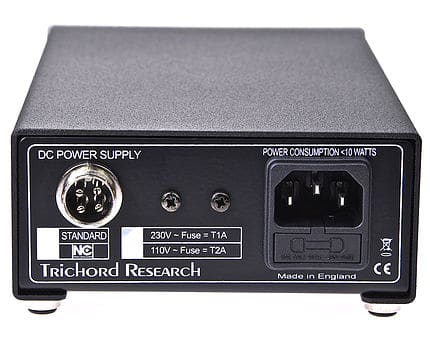
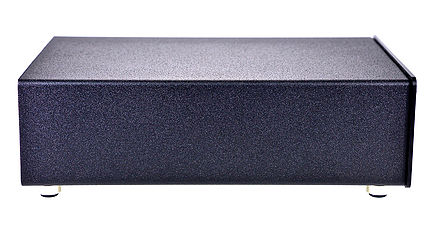
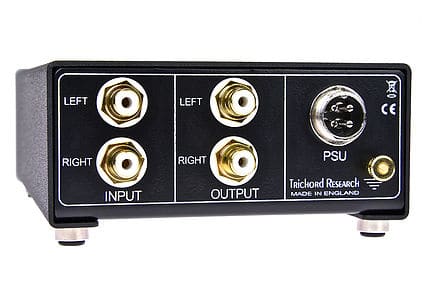
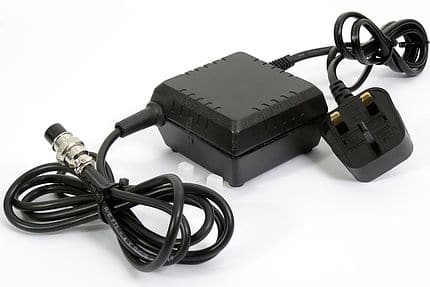
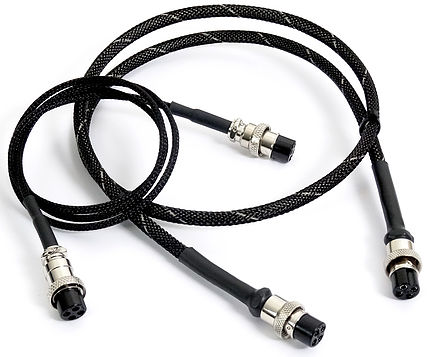




How much difference is there between mk1, mk2 and mk3
Goodness gracious, I think this old review needs a bit of updating the tidying up! It came from my old website and I don’t think the translation was the best 🙂 Apologies for the layout. Anyway, to your question, do you mean the difference between the basic Dino and the enhanced version with all of the trimmings? In very general terms, the basic is about ¬£500 and the suped up version is around ¬£1,000.
Hi not sure if this right place to ask simple ,linn ittok dynavector 20 x ,Cyrus cdi 8 xpd 2 x psx ( using creek phono 15 mk2) want to use either a AVID Pellar .tricord Dino , it’s hard to hear all of them, a rega aria ,I’ve looked at used but most phones over a couple of years old,tend to be improved, can you please, give some help, cables are teiiurium ultra black on cdi and black diamond on phono thank you in anticipation of your thoughts
Thanks for your question, Robert. I’d go for the Pellar but, then again, it is a much dearer product than the Dino and so should be better, sonically. The Aria is very good indeed (again, that is much dearer than the Dino) but I’d stick with the Pellar in terms of pure sound quality.